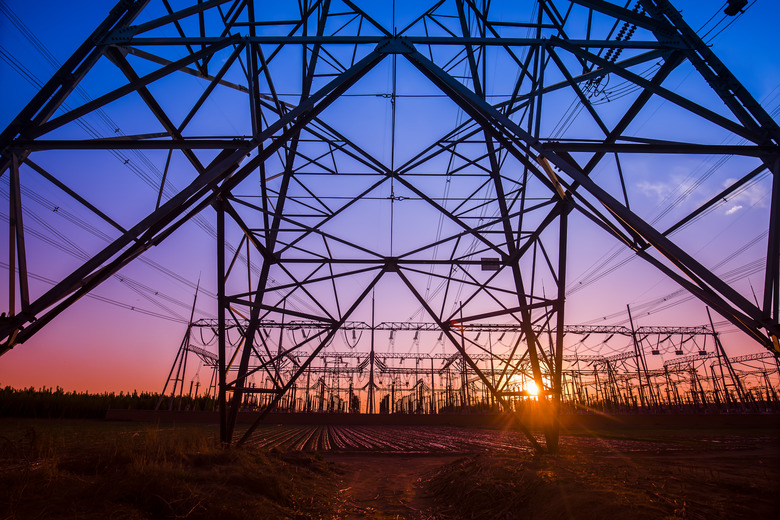How To Calculate Signal To Noise Ratio
In electronics and radio, the ratio of desired electronic signals to unwanted noise can vary over an extremely wide range, up to a billion times or more. The calculation for the signal-to-noise ratio (SNR) is either the difference of two logarithms or the logarithm of the ratio of the main and noise signals.
Electronic Signals and Noise
Electronic Signals and Noise
For better or worse, unwanted noise is a naturally occurring and inescapable part of signals in all electronic circuits and transmitted radio waves. Every circuit component, from transistors to resistors to the wiring, is made up of atoms that vibrate randomly in response to ambient temperature; the random vibrations produce electrical noise. In the air, radio transmissions pass through an environment full of electromagnetic interference (EMI) from power lines, industrial equipment, the sun, and many other sources. An electronics engineer wants to know, of the signal her equipment receives, how much is noise, and how much is desired information.
About Decibel Units
About Decibel Units
Scientists and engineers who work with signals often use measurements in decibel (dB) format in place of standard linear units like volts or watts. This is because, in a linear system, you'll either end up writing a lot of cumbersome zeros in your figures or resort to scientific notation. Decibel units, on the other hand, rely on logarithms. Though dB units take some getting used to, they make life easier by letting you use numbers that are more compact. For example, an amplifier has a dynamic range of 100 dB; this means the strongest signals are 10 billion times stronger than the weakest ones. Working with "100 dB" is easier than "10 billion."
Signal Measurement and Analysis
Signal Measurement and Analysis
Before doing the SNR calculation, you'll need measured values of the main signal, S, and the noise, N. You might use a signal strength analyzer that shows the signals on a graphic display. These displays typically show signal strength in decibel (dB) units. On the other hand, you may be given "raw" signal and noise values in units such as volts or watts. These are not dB units, but you can get to dB units by applying a logarithm function.
SNR Calculation – Simple
SNR Calculation – Simple
If your signal and noise measurements are already in dB form, simply subtract the noise figure from the main signal: S – N. Because when you subtract logarithms, it is the same as dividing normal numbers. The difference of the numbers is the SNR. For example: you measure a radio signal with a strength of -5 dB and a noise signal of -40 dB. -5 – (-40) = 35 dB.
SNR Calculation – Complicated
SNR Calculation – Complicated
To calculate SNR, divide the value of the main signal by the value of the noise, and then take the common logarithm of the result:
\(\text{SNR}=\log{\frac{S}{N}}\)
There's one more step: If your signal strength figures are units of power (watts), multiply by 20; if they are units of voltage, multiply by 10.
For power:
\(\text{SNR}=20\log{\frac{S}{N}}\)
For voltage:
\(\text{SNR}=10\log{\frac{S}{N}}\)
The result of this calculation is the SNR in decibels. For example, your measured noise value (N) is 1 microvolt, and your signal (S) is 200 millivolts. The SNR is:
\(\text{SNR}=10\log{\frac{0.2}{0.000001}}=53\text{ dB}\)
Meaning of SNR
Meaning of SNR
Signal-to-noise ratio numbers are all about the strength of the desired signal compared to the unwanted noise. The larger the number, the more the desired signal "stands out" in comparison to the noise, which means a clearer transmission of better technical quality. A negative number means the noise is stronger than the desired signal, which may spell trouble, such as a cell phone conversation that's too garbled to understand. For a fair-quality voice transmission such as a cellular signal, the SNR averages around 30 dB, or a signal that's 1,000 times stronger than the noise. Some audio equipment has an SNR of 90 dB or better; in that case, the signal is 1 billion times stronger than the noise.
Cite This Article
MLA
Papiewski, John. "How To Calculate Signal To Noise Ratio" sciencing.com, https://www.sciencing.com/how-to-calculate-signal-to-noise-ratio-13710251/. 2 November 2020.
APA
Papiewski, John. (2020, November 2). How To Calculate Signal To Noise Ratio. sciencing.com. Retrieved from https://www.sciencing.com/how-to-calculate-signal-to-noise-ratio-13710251/
Chicago
Papiewski, John. How To Calculate Signal To Noise Ratio last modified March 24, 2022. https://www.sciencing.com/how-to-calculate-signal-to-noise-ratio-13710251/
